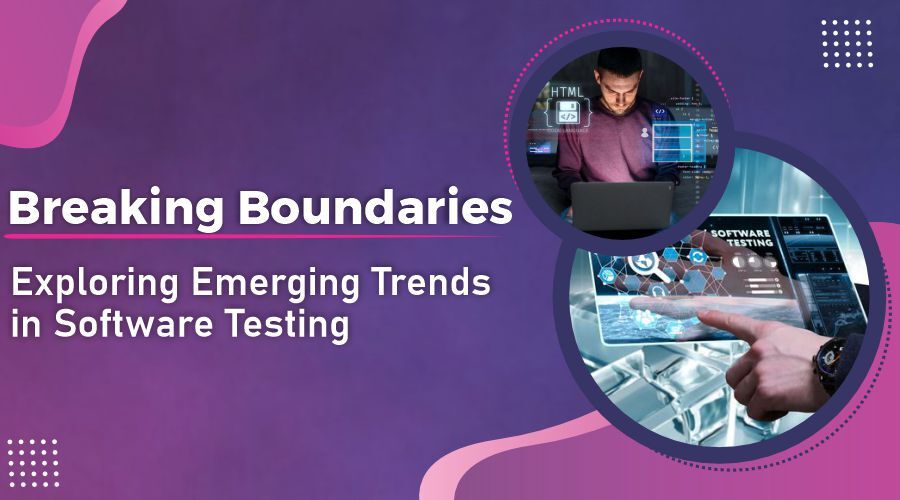Breaking Boundaries: Exploring Emerging Trends in Software Testing

AI is a technology that has been making waves in every industry, and the software development industry is no stranger to this trend. Software development and testing have been impacted by AI. Software tests with accuracy have become extremely important as development cycles and pace of development have been cut short by high demand and competition in the app ecosystem.
More and more companies are interested in creating software in the shortest possible time, and this can only happen when the testing tools are very fast and accurate. The use of software testing tools and professional skills are very important for proper deployment so that the outcome is favorable and easy to deploy.
The Rise of AI and Machine Learning in Testing
————————————-
-
AI-Powered Test Automation
Artificial intelligence is rapidly transforming the process of test automation and test cycle completion. The use of AI is a huge development among software testing trends that are prevalent today.
Many AI-powered tools test digital products today. For example, Applitools, Testim, and Selenium IDE are special tools that have AI-powered capabilities to create automated test cycles and manage them impeccably. These AI-powered tools help create test scenarios and complete them without major human intervention.
The benefits of software testing methodologies using automation are improved accuracy and less time taken to complete the test cycle. The automated test cycles are devoid of human error, and the testing tool tests at speed. The efficiency of the testing process is improved by manifold. The human testers can do more important work than repetitive test script creation for the same app software.
-
Predictive Analytics
Predictive analytics is a technology that is used to predict the occurrence of faults and issues in the software by using historical data of the software and data collected from other sources. The ability of AI to collect data and analyze it to help humans is something that is used in this case to predict issues before they form from risks.
These imminent risks are then immediately resolved so that the final quality of the digital product is highly improved and strong. Predictive analytics tools in testing environments can predict the risks and cyber threats associated with the developed software so that the risks can be mitigated on time without major damage to the software.
Leading software testing companies and tech giants like IBM and Microsoft Windows are using their software testing tools to predict the high-risk areas in their codes, which they can target during testing and correction. The predictive analytics tools are being used to predict bugs hidden in the code and then debug them on time.
How To Shift Towards Continuous Testing in DevOps?
————————————-
The integration of DevOps and testing processes can create continuous testing processes for software. The use of continuous testing helps increase the speed and efficiency of the testing algorithms and outcomes. The process of continuous testing is a very trending approach to software testing, which is well supported by modern tools and methodologies.
Continuous integration is done with continuous testing, where different components of the software are tested from time to time as they develop before they are integrated into the software architecture for complete functionality. A CI/CD pipeline speeds up the software development and deployment process so that the software is very easily tested and made ready for launch in the market.
Continuous testing, integration, and deployment go hand in hand with the creation of software that is ready to deploy in a short frame of time. Continuous integration ensures that all the code changes that are made after testing are integrated into the main wireframe quickly. The continuous deployment also ensures that the software is ready to be launched and in production mode.
Increased Adoption of Cloud-Based Testing Platforms
————————————-
-
Benefits of Cloud Testing
With new trends in software testing, there is more focus on using cloud-based testing environments that are easily accessible and very cost-effective. The cloud testing approach is very useful and scalable because professionals can access the on-demand resources and optimize the test algorithm.
Depending on the scale of the project, you can select the resources. There is also an amazing benefit of parallel testing, which allows multiple test scripts to run at the same time, boosting the testing speed. Moreover, the cloud-based testing environment is accessible round the clock from any system that has authorization for the same.
The traditional testing environments for software deployment are more manual-based and driven by human skill. These are not highly optimized or fast-paced. In this modern era, automated and feature-rich digital testing tools are better than the traditional testing process.
-
Security Concerns and Mitigations
Some security concerns are emerging from the use of cloud-based testing services. These security concerns are the storage of massive data sets and the possibility of data theft. This can be mitigated with the help of data encryption on different nodes of the test environment.
Moreover, there are rising concerns about unauthorized access through cyber hacking and threats. However, with the use of MFA and security monitoring technology, this possibility can also be reduced.
The best practices for secure testing in the cloud can be the use of data encryption techniques, highly secure monitoring systems, and firewalls when accessing devices. Authentication protocols and precautions taken when remote access is on also protect the data set and software from breaches.
Exploring the Potential of Blockchain in Testing
————————————-
-
Application in Test Security and Integrity:
Blockchain can be used to create immutable records of software testing audits and data. A decentralized database can create immutable data records for software testing, which can later be used for predictive analytics. This creates a high-integrity repository of software testing data that helps professional software testers.
The data integrity and security of the blockchain act as an additional firewall that protects the data by making it immutable and tamper-proof. The data from the software tests is conserved with the use of blockchain testing applications.
Enhancing Usability Testing with VR and AR
————————————-
The VR and AR technology are used to create real-life simulations for testing software on a usability basis. AR and VR tech are used to create simulations of user scenarios so that the usability of the application can be tested and improved based on the feedback gathered. This speeds up the usability testing process and also reduces dependence on real users before deployment.
AR and VR are used by leading companies to create real-time scenarios for usability and user training before deployment or in the beta testing phase.
The ability of the AR and VR tech to improve usability testing with scenario simulation and the creation of test cases is an advantage because it saves time and effort. It gives real results without excess resource spending or marketing.
However, the cost of AR and VR tech applications can be too high for small and mid-scale software development companies. The ongoing costs of such applications are also very high.
Embrace the Future: Explore New Software Testing Trends!
If you are ready to hire a software tester for your newly developed software program, then know about the software testing types and the test tools that professionals deploy. You should hire a well-known software testing company that has a team that is updated with software testing trends for proper and speedy tests. Trends such as AI and the use of predictive analytics in cloud-based environments demand more attention.




